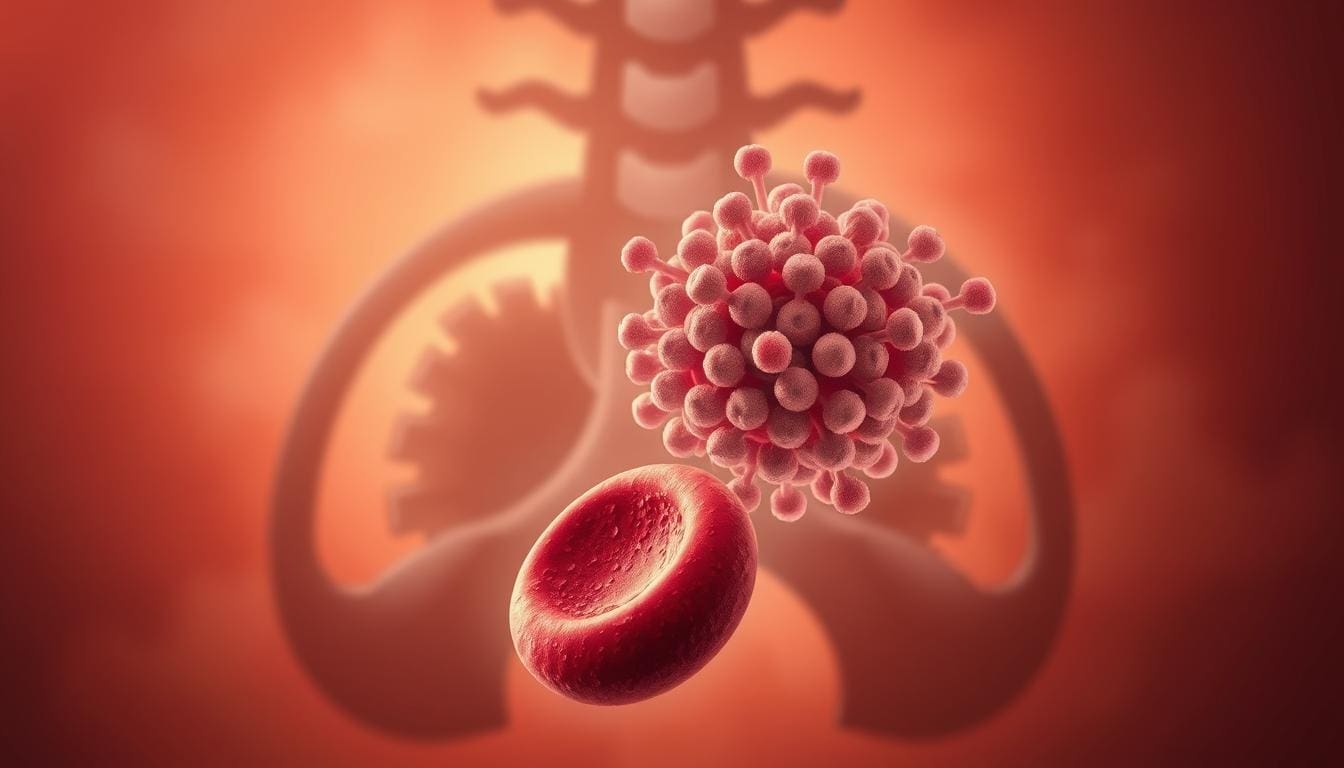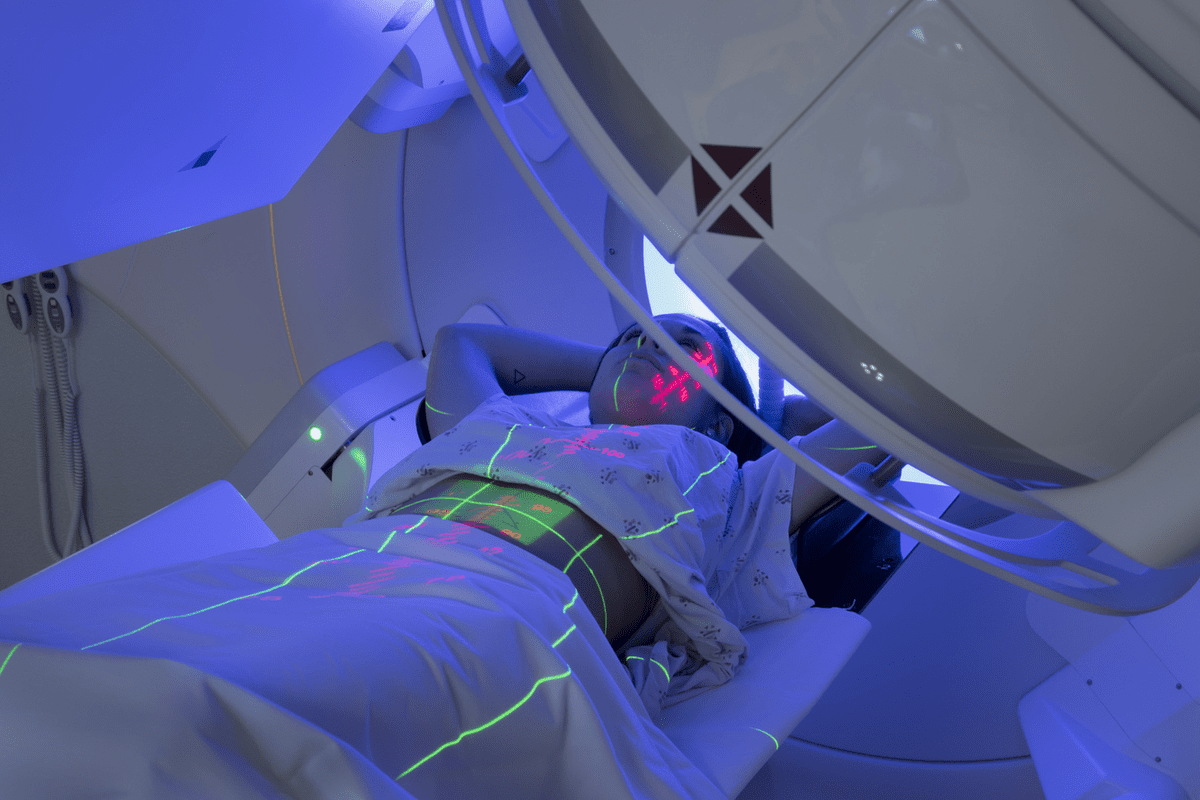What is the biggest indicator of ovarian cancer? Ovarian cancer is a big health issue worldwide. Knowing its early signs is key for good treatment. One in 78 women will be diagnosed with ovarian cancer in her lifetime. It’s vital to spot the warning signs early.
Early detection can greatly improve survival chances. Common symptoms include persistent bloating, abdominal pain, and trouble eating. These ovarian cancer symptoms are often confused with other issues, leading to delayed diagnosis.
Spotting ovarian cancer bloating and other early signs can save lives. We’ll look into these indicators to help women get medical help quickly.

Key Takeaways
- Ovarian cancer is a significant global health concern.
- Early detection is key for effective treatment.
- Common symptoms include bloating, abdominal pain, and eating difficulties.
- Recognizing early signs can improve survival rates.
- Prompt medical attention is essential upon noticing these symptoms.
Understanding Ovarian Cancer
Ovarian cancer is a complex and often misunderstood disease that affects thousands of women worldwide. It starts in the ovaries, which are part of the female reproductive system. Knowing about ovarian cancer is key for early detection and effective treatment.
What is Ovarian Cancer?
Ovarian cancer begins in the ovaries. These organs produce eggs and hormones. There are several types of ovarian cancer, with epithelial ovarian cancer being the most common. It starts in the outer layer of the ovary.
Types of Ovarian Cancer
There are three main types of ovarian cancer:
- Epithelial tumors: These are the most common type, arising from the outer layer of the ovary.
- Germ cell tumors: These tumors begin in the cells that produce eggs.
- Sex cord-stromal tumors: These are rare tumors that start in the connective tissue of the ovary.
Each type has different characteristics and requires a tailored approach to treatment.
Prevalence and Statistics in the United States
According to the American Cancer Society, ovarian cancer is the fifth leading cause of cancer deaths among women in the United States. In 2023, it is estimated that there will be over 19,000 new cases of ovarian cancer diagnosed, resulting in approximately 12,000 deaths. Understanding these statistics highlights the importance of awareness and early detection.
We recognize that ovarian cancer is a significant health issue. Being informed about its types and prevalence is the first step towards better outcomes. By understanding ovarian cancer, we can work towards improving diagnosis and treatment options for those affected.
The Challenge of Early Detection
Ovarian cancer is often found late, which highlights the need for better ways to detect it early. This problem is complex, involving the disease itself and current diagnostic methods.
Why Ovarian Cancer is Often Diagnosed Late
Ovarian cancer is often diagnosed late because its symptoms are not specific. These symptoms can be mistaken for other, less serious conditions. This can lead to delays in getting a diagnosis.
“The symptoms of ovarian cancer are often vague and can be mistaken for other conditions, making early detection difficult.” This shows how hard it is to diagnose ovarian cancer. We need more awareness and vigilance.
The Importance of Recognizing Warning Signs
It’s key to know the warning signs of ovarian cancer for early detection. A study in the Journal of Clinical Oncology found that knowing these signs can greatly improve treatment outcomes. Common signs include persistent bloating, pelvic pain, and feeling full quickly.
We must stress the importance of being aware of these symptoms. If they last, seek medical help. Early detection can greatly improve survival rates. It’s vital for both healthcare providers and the public to be informed.
The “Silent Killer” Misconception
The term “silent killer” is often used for ovarian cancer because it’s often without symptoms early on. But this term is misleading. It suggests ovarian cancer has no symptoms until it’s too late. In fact, many women do experience symptoms that could lead to earlier diagnosis if recognized.
“While ovarian cancer can be asymptomatic in its early stages, many women do experience symptoms that could lead to earlier diagnosis if properly identified.”
Understanding the challenges of early detection and the importance of recognizing warning signs is key. This way, we can improve outcomes for ovarian cancer patients.
Ovarian Cancer Symptoms: The Complete Picture
Ovarian cancer symptoms can be tricky to spot. Yet, some patterns and combinations need quick attention. Spotting these symptoms early can greatly improve treatment success and patient health.
Common vs. Rare Symptoms
Ovarian cancer symptoms can be both common and rare. Common signs include persistent abdominal bloating, pelvic pain, and urinary frequency. These are often mistaken for less serious issues, causing delays in diagnosis.
Rare symptoms include unexplained weight loss, changes in menstrual patterns, and fatigue. While these don’t always mean ovarian cancer, seeing several symptoms together should lead to a doctor’s visit.
How Symptoms Progress Over Time
Symptoms of ovarian cancer can change over time. At first, they might be mild and not always there. But as the cancer grows, symptoms get worse and last longer.
| Symptom | Early Stage | Late Stage |
| Bloating | Occasional, mild | Persistent, severe |
| Pelvic Pain | Intermittent, manageable | Constant, debilitating |
| Urinary Frequency | Frequent, but manageable | Urgent, with possible incontinence |
Symptom Clusters That Raise Concern
Some symptom combinations are more telling of ovarian cancer. These include:
- Bloating with pelvic pain
- Urinary frequency and abdominal discomfort
- Unintended weight loss with loss of appetite
Spotting these symptom clusters early can help catch ovarian cancer sooner. This can lead to better treatment results.
Persistent Abdominal Bloating: The Biggest Red Flag
Abdominal bloating is common, but it’s a big warning sign for ovarian cancer. Studies show it’s a key symptom in the early stages of the disease.
Why Bloating Occurs in Ovarian Cancer
Bloating in ovarian cancer comes from fluid buildup in the belly or tumors. These can make the belly swell. This symptom is often seen in many other, less serious conditions.
Tumors can mess with our body’s functions, leading to fluid buildup and swelling. In ovarian cancer, this can make the belly get bigger, causing discomfort and bloating.
Distinguishing Cancer-Related Bloating from Normal Bloating
Not all bloating is from ovarian cancer. But, some signs might point to a serious issue. For example, if bloating lasts a long time and you also have pelvic pain or trouble eating, see a doctor.
Key differences between normal and cancer-related bloating include:
- Persistence of bloating over several weeks
- Bloating accompanied by other symptoms like pain or loss of appetite
- Significant discomfort or swelling
When to Be Concerned About Bloating
If you have bloating that doesn’t go away with usual fixes or is with other worrying signs, see a doctor. Early check-ups can find the cause and start the right treatment.
Being aware of ovarian cancer symptoms is key. Spotting them early can greatly improve treatment results.
Pelvic and Abdominal Pain: Critical Warning Signs
Ovarian cancer often shows up as pelvic and abdominal pain. These symptoms are common and very important for early detection. We will look at the types of pain, where it hurts, and how it’s linked with other symptoms.
Characteristics of Ovarian Cancer Pain
The pain from ovarian cancer can feel like a dull ache or a sharp stab. Knowing what this pain feels like is key to catching it early. Studies show that women with ovarian cancer often have pain that doesn’t go away with usual treatments.
A study in a well-known medical journal found that pain is a main symptom for many ovarian cancer patients.
Location and Patterns of Pain
The pain’s location and pattern can tell us a lot. It usually hurts in the pelvic area or lower belly. But it can also spread to the back or thighs.
- Pelvic pain happens when a tumor presses on nearby parts.
- Abdominal pain might be from fluid buildup or the disease spreading.
- The pain can stay the same or get worse over time.
Pain Combined with Other Symptoms
When pain is joined with other signs, it’s a big warning for ovarian cancer. Symptoms like bloating, trouble eating, or needing to pee a lot are also red flags. Seeing many symptoms together means you should see a doctor right away.
| Symptom | Description | Clinical Significance |
| Pelvic Pain | Dull ache or sharp pain in the pelvic region | May indicate tumor presence or spread |
| Abdominal Pain | Pain or discomfort in the lower abdomen | Could be related to fluid accumulation or disease progression |
| Bloating | Feeling of swelling or tightness in the abdomen | Often associated with ovarian cancer |
A medical expert says, “Pelvic pain, abdominal bloating, and other stomach issues need a full check for ovarian cancer.”
“Persistent pain, with symptoms like bloating or changes in urination, needs a detailed medical check to rule out ovarian cancer.”
A medical oncologist
We stress the need to see pelvic and abdominal pain as warning signs for ovarian cancer. By knowing the pain’s characteristics, where it hurts, and how it’s with other symptoms, women can get help early. This could lead to better health outcomes.
Urinary and Digestive Changes as Key Indicators
Changes in urination and digestion can signal ovarian cancer. These signs might seem minor but are important to notice. They could mean something serious.
Frequent Urination and Urgency
Frequent need to urinate and feeling urgent are signs of ovarian cancer. The tumor can press on the bladder. This makes you feel like you need to go more often or urgently. Studies show women with ovarian cancer often experience these symptoms, affecting their daily lives.
Constipation, Diarrhea, and Other Digestive Issues
Ovarian cancer can cause digestive problems like constipation and diarrhea. The tumor can press on the intestines or change hormone levels. Changes in bowel habits that last can be a warning sign for ovarian cancer.
| Symptom | Description | Potential Cause |
| Frequent Urination | Needing to urinate more often than usual | Pressure on the bladder from the tumor |
| Constipation | Difficulty in passing stools or infrequent bowel movements | Tumor pressure on the intestines or hormonal changes |
| Diarrhea | Frequent or loose stools | Irritation of the intestines or metastasis |
When Digestive Symptoms Signal Cancer
Constipation and diarrhea can have many causes. But if they keep happening or get worse, it could be ovarian cancer. Seeing a doctor if these symptoms don’t go away is key. Early check-ups can find the cause and start treatment.
Talking about these symptoms might feel hard, but it’s important. Knowing these signs and getting help can help women stay healthy.
Feeling Full Quickly and Loss of Appetite
Women with ovarian cancer often feel full fast and lose their appetite. This can really hurt their health. These signs aren’t just about digestion. They also show how the disease is growing.
The Connection to Tumor Growth
Feeling full quickly is often because of the tumor growing. As it gets bigger, it can push on the stomach and other organs. This makes the stomach smaller and you feel full even after eating a little.
Tumor growth also makes you eat less. The body changes how it uses energy and metabolism because of the tumor. This makes you want to eat less.
Distinguishing from Other Digestive Conditions
Feeling full quickly and not wanting to eat can be signs of ovarian cancer. But, they can also mean other digestive problems. It’s key to tell them apart to get the right treatment.
| Symptom | Ovarian Cancer | Other Digestive Conditions |
| Feeling Full Quickly | Tumor pressing against the stomach | Gastroparesis, Gastritis |
| Loss of Appetite | Metabolic changes due to tumor | Depression, Gastrointestinal disorders |
Impact on Nutrition and Health
Feeling full fast and not wanting to eat can really affect women with ovarian cancer. They need to eat well to stay strong and handle treatment side effects.
Eating the right foods in small, frequent meals is key. This helps manage symptoms and keeps them healthy during treatment.
Fatigue, Weight Changes, and Systemic Symptoms
Ovarian cancer often shows up through symptoms like fatigue and weight changes. These can really affect a person’s quality of life. Even though these signs aren’t specific, they’re important to watch and check out.
Unexplained Weight Loss or Gain
Women with ovarian cancer might notice unexplained weight changes. This can be either losing or gaining weight. Unexplained weight loss might happen because the tumor uses more energy. On the other hand, some might gain weight due to fluid buildup or a bigger tumor.
It’s key to figure out if weight changes are from ovarian cancer or something else. This could be diet changes or hormonal shifts. A detailed medical check-up is needed to find out why someone’s weight is changing.
Persistent Fatigue and Its Significance
Persistent fatigue is a big problem for ovarian cancer patients. It’s a deep, lasting tiredness that doesn’t get better with rest. This can happen because of how the cancer affects the body, anemia, or other disease-related issues.
Fatigue can really mess with a person’s daily life and happiness. Seeing fatigue as a sign of ovarian cancer is important. It can lead to finding the disease sooner.
Other Systemic Changes
Ovarian cancer can also cause other symptoms like changes in bowel habits or needing to pee more often. These symptoms can be hard to pinpoint and are often thought of as other things. This makes it tough to diagnose ovarian cancer just by looking at symptoms.
To find out what’s causing these symptoms, a full medical check-up is needed. This includes talking to the patient, doing a physical exam, and running tests. Doctors should think about ovarian cancer when they see these symptoms in women.
Menstrual Irregularities and Gynecological Symptoms
Menstrual irregularities and other gynecological symptoms can be signs of ovarian cancer. Women with unusual menstrual patterns or symptoms should know the risk of ovarian cancer.
Changes in Menstrual Patterns
Changes in menstrual patterns are a big concern for women. Ovarian cancer can cause irregularities, like heavier or lighter bleeding, or even stop menstruation.
These changes might be due to the tumor’s effect on hormone production. It’s key for women to track their cycles and tell their healthcare provider about any irregularities.
Postmenopausal Bleeding
Postmenopausal bleeding is a symptom that needs immediate medical attention. Any vaginal bleeding after menopause is abnormal and should be checked.
Ovarian cancer can cause this bleeding because of hormone production. This symptom can lead to early detection if reported and checked right away.
Pelvic Pressure and Discomfort
Pelvic pressure and discomfort are symptoms linked to ovarian cancer. Growing tumors can press on nearby structures, causing discomfort or pressure in the pelvic area.
This symptom might not be specific and could be from other conditions. But, when combined with other symptoms, it can hint at ovarian cancer.
| Symptom | Description | Potential Cause |
| Changes in Menstrual Patterns | Irregularities in menstrual cycles, including heavier or lighter bleeding | Hormonal influences from the tumor |
| Postmenopausal Bleeding | Vaginal bleeding after menopause | Hormone production stimulating the uterine lining |
| Pelvic Pressure and Discomfort | Feelings of discomfort or pressure in the pelvic area | Tumor growth exerting pressure on surrounding structures |
Late-Stage Indicators of Ovarian Cancer
It’s important to know the late signs of ovarian cancer to help patients. As the disease gets worse, symptoms can get severe. These symptoms can really hurt a patient’s quality of life.
Ascites (Fluid Buildup)
Ascites is a key sign of ovarian cancer in its late stages. It’s when fluid builds up in the belly. This can cause pain, trouble breathing, and swelling.
Characteristics of Ascites:
- Fluid accumulation in the peritoneal cavity
- Can cause abdominal distension and discomfort
- May lead to respiratory difficulties
Severe Abdominal Distension
Severe swelling in the belly is another sign of late-stage ovarian cancer. This happens when fluid or tumors grow. It makes the belly swell a lot, causing pain and making it hard to do daily tasks.
| Symptom | Description | Impact on Patient |
| Ascites | Fluid buildup in the peritoneal cavity | Discomfort, breathing difficulties |
| Abdominal Distension | Significant swelling of the abdomen | Discomfort, limited mobility |
| Respiratory Difficulties | Difficulty breathing due to fluid or tumor pressure | Reduced oxygen intake, fatigue |
Respiratory Difficulties
Respiratory problems are a serious issue in late-stage ovarian cancer. Fluid or tumors can press on the lungs and diaphragm. This leads to shortness of breath and other breathing troubles. We need to act fast to help patients breathe better.
Knowing these signs helps doctors give better care. They can help manage symptoms and improve life for patients with ovarian cancer.
Diagnostic Process for Ovarian Cancer
The journey to diagnose ovarian cancer is complex. It involves several steps to accurately find and stage the disease. This process uses clinical checks, imaging, and lab tests.
Initial Evaluation and Physical Examination
The first step is a detailed medical history and physical check-up. We look at symptoms, health, and risk factors to decide on more tests. A pelvic exam is key to spotting signs of ovarian cancer.
Key components of the initial evaluation include:
- Detailed medical history
- Pelvic examination
- Assessment of symptoms and risk factors
Imaging Studies: Ultrasound, CT, and MRI
Imaging tests are critical in diagnosing ovarian cancer. Ultrasound is often the first test, showing the ovaries and any issues. CT scans give detailed views of the abdomen and pelvis, helping to see tumor size and spread. MRI might be used to look at masses or check for metastasis.
Experts say, “Imaging tests are key to seeing how far ovarian cancer has spread and to decide on treatment.”
“The use of imaging modalities like ultrasound and CT scans has significantly improved our ability to detect and stage ovarian cancer.”
Blood Tests and Tumor Markers
Blood tests, like the CA-125 tumor marker test, help in diagnosis and treatment monitoring. An elevated CA-125 level can suggest ovarian cancer, mainly in postmenopausal women.
Other blood tests check overall health and organ function. These tests help see if a patient is ready for certain treatments.
Surgical Diagnosis and Staging
Surgery is the best way to diagnose and stage ovarian cancer. During surgery, tissue samples are taken for biopsy, and the disease extent is checked. This info is key for cancer staging and treatment planning.
Surgical staging involves:
- Exploration of the abdominal cavity
- Biopsy of suspicious tissues
- Removal of the ovaries and other affected organs
Getting an accurate diagnosis and staging is vital for a good treatment plan. By using clinical checks, imaging, blood tests, and surgery, we ensure patients get the right care for their needs.
Risk Factors and Prevention Strategies
Understanding risk factors and prevention strategies is vital in fighting ovarian cancer. We will look at what increases the risk of ovarian cancer. We will also talk about how to lower this risk.
Genetic and Family History Factors
Genetic mutations, like in the BRCA1 and BRCA2 genes, greatly raise ovarian cancer risk. A family history of certain cancers also matters. Women with a family history or genetic risk should talk to their doctor about screening and prevention.
Genetic Risk Factors:
- BRCA1 and BRCA2 mutations
- Other genetic syndromes (e.g., Lynch syndrome)
- Family history of ovarian or breast cancer
Lifestyle and Environmental Factors
Lifestyle and environmental factors also affect ovarian cancer risk. These include reproductive history, medication use, and chemical exposure.
| Lifestyle Factor | Impact on Ovarian Cancer Risk |
| Reproductive History | Early menstruation, late menopause, or never having children may increase risk |
| Talcum Powder Use | Potential increased risk with genital talcum powder use |
| Hormone Replacement Therapy | Some studies suggest an increased risk with certain types of HRT |
Preventive Measures and Screening Options
While there’s no guaranteed way to prevent ovarian cancer, some steps can help. These include using oral contraceptives, breastfeeding, and surgery for high-risk individuals.
Screening for ovarian cancer includes pelvic exams, imaging tests, and blood tests. For those at high risk, more intense screening and prevention plans may be suggested.
Knowing and tackling ovarian cancer risk factors can lead to early detection. This can help lower the death rate from this disease.
Conclusion: Taking Action on Ovarian Cancer Symptoms
Knowing the signs of ovarian cancer is key to catching it early. We’ve looked at common symptoms like persistent bloating, pain, and other changes. These signs are important to watch for.
Women who notice these symptoms should see a doctor right away. This can lead to better treatment and health outcomes. Early action is vital in fighting ovarian cancer.
There are many ways to treat ovarian cancer today, like surgery and new medicines. By knowing the symptoms and treatment choices, women can manage their health better. This empowers them to make smart choices about their care.
FAQ
What are the most common symptoms of ovarian cancer?
Symptoms of ovarian cancer include persistent bloating and pain in the abdomen. You might also notice changes in urination and digestion. Feeling full quickly and losing appetite are other signs.
Why is ovarian cancer often diagnosed at an advanced stage?
Ovarian cancer is often diagnosed late because its symptoms are not specific. These symptoms can be similar to those of other conditions. This makes it hard to catch early.
What is the significance of persistent abdominal bloating in ovarian cancer?
Persistent bloating is a key warning sign for ovarian cancer. It can indicate tumor growth and fluid buildup in the abdomen.
How is ovarian cancer diagnosed?
Diagnosing ovarian cancer involves several steps. First, there’s an initial evaluation. Then, imaging studies and blood tests are done. The final step is surgical diagnosis.
What are the risk factors for ovarian cancer?
Risk factors for ovarian cancer include genetic and family history. Lifestyle and environmental factors also play a role. Certain medical conditions can increase risk.
Can ovarian cancer be prevented?
While there’s no sure way to prevent ovarian cancer, understanding risk factors is key. Taking preventive measures like screening and early detection can help reduce risk.
What are the treatment options for ovarian cancer?
Treatment for ovarian cancer depends on the cancer’s stage and type. It also depends on your overall health. Options include surgery, chemotherapy, and other therapies.
How does ovarian cancer affect menstrual patterns?
Ovarian cancer can change menstrual patterns. You might experience irregular periods, heavy bleeding, or bleeding after menopause.
What are the late-stage indicators of ovarian cancer?
Late-stage ovarian cancer can cause ascites and severe abdominal distension. It can also lead to respiratory difficulties.
Can ovarian cancer cause urinary symptoms?
Yes, ovarian cancer can lead to urinary symptoms. These include frequent urination and urgency. This is due to tumor growth and pressure on the bladder.
How does ovarian cancer impact overall health?
Ovarian cancer can significantly affect overall health. It can cause fatigue, weight changes, and other systemic symptoms. These can impact your quality of life.
What is the role of genetic testing in ovarian cancer diagnosis?
Genetic testing can identify genetic mutations that increase ovarian cancer risk. This allows for early detection and prevention.
How can women reduce their risk of ovarian cancer?
Women can lower their risk of ovarian cancer by understanding risk factors. Taking preventive measures and seeking medical attention for persistent symptoms are important.







